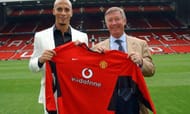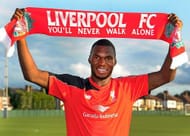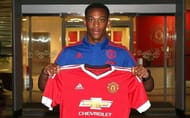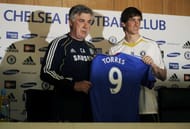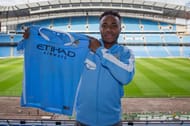With Paul Pogba inching ever closer to a €120million blockbuster move to Jose Mourinho’s Manchester United revolution, the Premier League’s gigantic €6.9 billion TV deal is already showing its incredible, unstoppable pulling power. Real Madrid, Barcelona, Bayern Munich & Paris St-Germain have all been pursuing the jewel from Juventus, but super-agent Mino Raiola and his man are about to seal the deal that will shatter the British and global transfer record.
In fact, some might say it’s only the beginning as Leicester City’s incredible title win last season only boosts the Premier League’s popularity around the globe. The twists and turns of the most-watched league on the planet don’t only happen on the pitch; the drama in the conference room, the touchline tantrums and managerial merry-go-round all add to the Premier League’s fantasy-like attraction.
More than anything, the Premier League’s big-money signings in summer & winter are always a sign of its rude health. Now, as we watch all the major summer transfers unfold, is a perfect time to go back to the days when the Premier League transfer record was smashed. Will it be done again this season? Mr. Paul Pogba, it’s your call!
10 . Juan Mata (from Chelsea to Manchester United 2013/2014) – €44.7 million
They have unthinkably been reunited at Manchester United, but for Jose Mourinho & Juan Mata, it will not all be hugs and kisses. Back at the start of the 2013/2014 season, everything seemed rosy for both parties. Juan Mata had just won the Chelsea Player of the Year award for a second consecutive time – and it was just as well-deserved as the first.
He’d become a key part of the Chelsea side that won 2 European titles in two years, sweeping in the corner for Drogba’s equalizer in Munich (2012) & Ivanovic’s injury-time winner in Amsterdam (2013). He had scored 32 goals and made over 50 assists in his 2 years there, becoming Chelsea’s widely-loved “Johnny Kills” – one of their best No.10s ever.
On the other side was the returning hero, Jose Mourinho. After the dire football and vociferous reaction from the fans in the terraces at the unjust sacking of legendary footballer and European Cup-winning manager Roberto Di Matteo and the appointment of ex-Liverpool Rafael Benitez, this was the signing to unite everyone.
With so much unfinished business from his first stint and a dire time at Real Madrid, he’d gone back to his home. The media nicknamed him “The Happy One”, a play on his former moniker “The Special One”. Everyone did seem quite happy at that point.
Although Mourinho stated how much he liked Brazilian youngster Oscar, nobody could have imagined how things would pan out. In the football Jose Mourinho wanted his Chelsea team to play, Juan Mata was the odd man out. Despite his 4-dimensional vision, incredible skill, and deadly set-pieces, he was not the hardworking box-to-box No10 hybrid Mourinho wanted.
Simultaneously, Oscar’s hard running, clever passing, and impressive tenacity won him a starting spot. Things came to boil at the St. Mary’s Stadium when Chelsea were struggling against Mauricio Pochettino’s strong Southampton side.
Juan Mata was far from the worst player on the pitch, but after about an hour of play Mourinho had seen enough. He brought the diminutive Spaniard off, and he could not hide his frustration, clearly protesting the decision on the substitutes bench. Oscar came on in his place, and within minutes Chelsea were 3-0 up.
It was a damning moment for Mata’s Chelsea career and despite Mourinho stating that he wanted Mata to stay, he was moved on to Moyes’ Manchester United in January for an enormous €44.7 million.
His time there has yielded a series of mixed reviews. Despite his eagerness to involve himself in their football, he has been played in the same wide position that saw him register the most average performances in his career. In Moyes’ team, he was an alright part of a very mediocre outfit.
In Van Gaal’s United, he scored and assisted more but couldn’t nail down a consistent starting XI spot as players were played out of position and in an uncomfortable system. Despite posting 26 goals and over 20 assists in 104 appearances, his only truly splendid moment came with a brace at Anfield (including a terrific bicycle kick). Now, he’s back with the man who didn’t trust him to lead his Chelsea side. Will it be different this time round?
9. Granit Xhaka (from Borussia Monchengladbach to Arsenal 2016/2017) – €45 million

Switzerland superstar and ex-Borussia Monchengladbach captain Granit Xhaka is only 23 years old, but he is already one of the league’s priciest acquisitions. The fact that the famously pennywise Arsene Wenger splashed such big bucks on him only lends more weight to the assertion that he is one of the Bundesliga’s finest exports in recent years.
Xhaka first came to international prominence with FC Basel, as he became an integral part of the side that relied on his and Xherdan Shaqiri’s mercurial talents to win a league and cup double. With 61 appearances in his two seasons there, he won back-to-back league titles and was named the Swiss Young Player of the Year.
Germany was his next port of call, with Borussia Monchengladbach purchasing him to beef up their midfield – which he surely did. Despite their campaign beginning awfully (culminating in Lucien Favre’s sacking), Xhaka was a brilliant gem in the side. In his 4 years in Germany, his immense passing range and powerful frame helped his club rise to 4th spot in the Bundesliga, as well as drawing comparisons with Bayern Munich’s World Cup winner Xabi Alonso.
A Sweden international since the age of 18, he has already carved out a spot for himself in the national team, earning 44 caps and scoring 6 goals. His no-nonsense defending from the midfield position has seen him get sent off 8 times already, but he made amends on his 5th with Gladbach by giving away €20,000 to charity.
The Swiss star was a part of their powerful Euro 2016 squad that lost to Poland; unfortunately, he missed a decisive spot-kick after extra time. With a splendid left foot and a vision that guided his club up the Bundesliga standings (he started every match for them in 2014/2015), he quickly showed just why ex-Basel coach Thorsten Fink labelled him as the “best talent in Switzerland”. Now he’s in the Premier League and Arsenal fans will be licking their lips at the prospect of having scooped one of the planet’s most dynamic central midfielders.
8. Rio Ferdinand (from Leeds to Manchester United 2002/2003) – €46 million
Arguably Manchester United’s greatest defender ever, Rio Ferdinand is a man whose name is synonymous with top-class defending. Scouted by Frank Lampard’s father for West Ham’s back in 1992, the defender has been the subject of high-profile bids for what seems like an eternity.
His rise to the first team was unstoppable – by the age of 19, West Ham United fans voted him the Hammer of the Year – a tribute to his impressive 46 games in the heart of their defence. After almost 160 games for West Ham, the big clubs could no longer hold back and Leeds United broke their transfer record to make Ferdinand the most expensive defender in history for €26 million. The following year he was club captain aged just 22; at which point he had already become the youngest defender to ever play for England.
A key player in their semi-final stage exit in the 2000/2001 Champions League campaign, Ferdinand was everything they’d paid for, and more! After 73 appearances and 3 goals in just 2 seasons, however, Leeds’ well-documented financial issues meant they had to let go of their star player to Ferguson’s Manchester United.
Once again, Rio Ferdinand was on the move, and once again, he was to break the transfer record for a defender. This time, Manchester United spent more than they had ever done on any player – a stunning statement of the 23yr-old’s ability. For €46 million, Rio Ferdinand signed for Manchester United in the summer of 2002. The rest, as they say, is history.
The next 12 years of his career were a story of style, power and leadership as he led Manchester United to 6 Premier League titles, 3 League cups, 1 Champions League victory & 1 Club World Cup. His immense displays earned him 81 caps for his country, as well as immense respect from all his peers.
A 6-time PFA Team of the Season winner, he became the bedrock of Manchester United’s domestic success, appearing over 450 times for the Red Devils. After his contract expired in 2014, he opted to go for one last season with QPR, suffering relegation just a year after scoring the final goal of the highly-successful Ferguson era.
He has become a global symbol of top-quality defending and can be heard and seen on many TV Channels today. His name is synonymous with United’s success, and with the words “big-money defender”!
7. Christian Benteke (from Aston Villa to Liverpool 2015/2016) – €46.5 million
Liverpool’s Congolese-born striker was purchased from relegated Aston Villa for a princely sum. In fact, Brendan Rodgers prizing him away was probably the straw that broke the camel’s back as the Birmingham-based side dropped to the 2nd tier for the first time since 1987, scoring just 27 goals in 38 league matches. Their form was disastrous all season, picking up just 3 wins – 6 fewer than the second-worst team in the division!
Christian Benteke made a blistering start to his English career, netting 23 goals in 39 games as he formed the fulcrum of Paul Lambert’s side, despite them finishing 15th in the league (in 2012/2013). His performances attracted rave reviews as he came second in the PFA Young Player of the Year award to the mercurial Gareth Bale.
His 19 league goals remain a club record since the Premier League’s inception, and he quickly became a target for top clubs across the country. His second season was marred by injuries, but he still managed a respectable 11 goals in 28 matches. Unfortunately, his season ended early as he ruptured his Achilles tendon in April 2014.
By the end of the following season (2014/2015), he had struck 42 league goals in 89 matches for Aston Villa; almost a 1-in-2 ratio. That was quite unheard of for a team lying in the lowest reaches of the league table. Eventually, Brendan Rodgers had seen enough and shelled out €46.5 million for the man who was to head his new Suarez-less attack.
Things started excellently as he scored with against Bournemouth in his second game for Liverpool. However, Rodgers’ system failed to bring the best out of his traditional target-man, and he found difficulties adjusting to the new style he was meant to play. Moreover, other elements of Rodgers’ expensively assembled team failed to click.
One picturesque bicycle kick against Manchester United could not save his side from defeat, and they lost 3-1 at Anfield. Rodgers was sacked soon after for ex-Borussia Dortmund manager Jurgen Klopp, but he again struggled to match his team’s play and was sidelined for several fixtures. Despite his omission from some key matches, he scored twice against Chelsea, as they won 3-1 away and drew 1-1 at home in the final league match.
His Liverpool career is still very much up in the air – his quality is obvious, but can he bounce back from a tough first season? 10 goals in 29 games sound decent, but he will need to better that if he is to keep a spot in Klopp’s new team.
6. Mesut Ozil (from Real Madrid to Arsenal 2013/2014) – €47 million
Mesut Ozil had proven his amazing ability at Schalke 04 before being snapped up by Werder Bremen, where he assisted 55 goals in 108 appearances, scoring 16 himself as well. That amazing form was sure to draw the big guns, but it wasn’t before the 2010 World Cup in South Africa (he was 21 back then) where people saw his ability to affect matches at the highest level.
Despite Germany losing out to eventual champions Spain in the semi-finals, his amazing displays propelled him to the forefront of the football world. That earned him a move to Jose Mourinho’s Real Madrid, where his talent was used to its most devastating extent.
Registering 25 assists and 10 goals, he became Europe’s supreme goal-provider as the likes of Cristiano Ronaldo broke goalscoring records at his side. Brazilian Kaka was meant to play a major part in the team, but Ozil’s amazing talent and the former’s injury meant that it as Ozil became Real Madrid’s de facto creative hub; in his very first season too!
In the following campaign, he was assigned the number 10, making his status as their go-to creator official. He impressed once again, scoring 7 goals and laying on another 17 as Real Madrid shattered the goals and points record in La Liga on the way to their 32nd title. 2012/2013 was another personally amazing season for Ozil as he reached the peak of his personal performances, netting 10 times and assisting an incredible 29 goals for his teammates.
Despite his desire to stay at Real, he was the subject of a massive bid from Arsenal just 2 games into the new season. It was accepted and Mesut Ozil signed on as Arsenal’s most expensive player ever – a surprising outlay and a gigantic endorsement from Wenger, who rarely spends so much on a football player.
His Arsenal career started impressively as he immediately assisted new teammate Olivier Giroud. 3 weeks later, he showed his ability to dominate matches, making 2 assists and striking a freekick that led to the third goal in a 3-1 victory over Stoke City. His combined performances for Arsenal & Real Madrid saw him make the Ballon D’Or nominees list once again.
His impact on Arsenal was clear in May, as his 13 assists and 7 goals led Arsenal to their first major trophy in 9 years as they beat Hull City 3-2 in the FA Cup final. The following seasons was a bit more difficult as he sustained an injury in their 2-0 loss to eventual champions Chelsea, but in 31 games he contributed 5 goals and 7 assists and creating many more chances.
At the end of the season, he won his second FA Cup medal as Aston Villa were smashed 4-0 in the final. 2015/2016 began with Arsene Wenger predicting his best season in England, which was an accurate statement. Surpassing 100 appearances for Arsenal, Mesut Ozil scored 8 goals and laid on an incredible 19 league assists, placing him just below Thierry Henry in the all-time assist charts for a single Premier League season.
5 . Anthony Martial (from Monaco to Manchester United 2015/2016) – €50 million
Manchester United feature heavily on this list, as they’ve broken the British transfer record more than any other club to keep their position as the record title-holders in England. However, Ed Woodward and his transfer dealings have come under serious fire at times, especially during the painful Moyes and dreary Van Gaal eras. With several high-profile targets like Toni Kroos & Sergio Ramos being chased all summer before sealing moves to other clubs or new contracts, they’ve not been so great, to be honest.
So when rumours of Anthony Martial (who?) signing on from Monaco began to abound, it seemed like another strange transfer. Why pay for another youngster when so many young players were in the Red Devil’s academy? Where were the Ibrahimovics, the Lewandowskis, and Mullers? By the way, was he being signed for the first team or the under-19s?
Imagine the laughter from Liverpool and other rival fans when an amazing €61million transfer was rumoured to be agreed! When it was officially announced, it turned out to be less than that – but still an eye-watering sum! He became the planet’s most expensive teenager, and also the 5th priciest player to go to England. His previous stats? Just 15 goals in 68 appearances, but Van Gaal and Woodward knew why they’d purchased him.
The media almost immediately labelled him a flop, to the giggles of millions of rival fans. The man with the stony face stayed that way, even as he made the bench for Manchester United’s match away at Anfield.
Then, on the 65th minute Louis Van Gaal, threw him on, with Manchester United leading 2-1 in a difficult encounter. On came the overpriced, overrated teenage ‘flop’ as Van Gaal used the summer’s millions in the biggest clash in England. A few enticing runs apart, nothing could be seen of United’s expensive acquisition. Then, the moment came.
With Liverpool chasing the game hard, United gathered the ball and countered. Suddenly, Martial got the ball, with the visiting crowd spurring him on. He needed nothing else. With the same stony faces as a quiet assassin, Martial picked the ball up 20-odd yards from goal.
He sprinted away and with a slaloming run, put the ball past veteran defender Martin Skrtel’s legs and bore down on Mignolet’s goal. Without so much as a breath, he stole away and slotted the ball home, wheeling away in a frenzied celebration.
The critics bit their tongues in grudging respect as his composure and fearsome skill on the ball immediately drew comparisons to Arsenal’s Thierry Henry. By the end of the season, he had scored 17 goals and made more than 10 assists, becoming United’s most dangerous player as he combined speed, dribbles, and intelligence to mark a devastating debut season in the Premier League.
Despite his tender years and constant fielding out wide, Anthony Martial had just shown the world why he had cost so much despite doing so little in the game. With every dribble and every clever pass, his status grew as fast as his doubters shrunk. The teenage ‘flop’ had just shown everyone who doubted (or didn’t know him, like teammate and captain Wayne Rooney) why he’d been so highly-coveted by Manchester United.
4. Fernando Torres (from Liverpool to Chelsea 2010/2011) – €58.5 million
As Chelsea fans would know, Roman Abramovich is the kind of person who often tends to get what he wants. In Fernando Torres, he would’ve started wondering if what we really want is always what’s best for us.
His Chelsea team regained the Premier League after 5 years with a record number of goals and some truly imperious performances, so Roman Abramovich ought to have been happy. Carlo Ancelotti had basically achieved what everybody assumed was his dream – trophies, respect and some truly ‘sexy football’.
Despite a quarter-final loss to Jose Mourinho’s eventual treble winners in the Champions League (which must have been quite galling), Chelsea had won their first-ever FA Cup & Premier League double. In the summer of 2010/2011, millions were splashed out in a bid to finally conquer Europe.
Despite an impressive start to the 2010/2011 season, the form of Chelsea’s veterans took a small dip which made their play painfully slow and somewhat predictable. Above all, the replacements seemed inadequate to fit Ancelotti’s system. As usual, cracks began to appear in the Chelsea hierarchy, with a mysterious new figure appearing on the Chelsea bench – a certain Michael Emenalo, whose in-house duties had suddenly grown exponentially. With January (and the Champions League) fast approaching, something had to be done.
Far away in Liverpool, the once-dominant Fernando Torres was struggling with some of the worst injuries in his career. In 26 appearances in 2010, he’d scored just 9 goals as he struggled to recover from a painful knee injury. Liverpool were faring very poorly without their talisman’s usual contribution as nobody could finish the evergreen Steven Gerrard’s long balls and top-notch set-pieces.
A huge tormentor of Chelsea’s throughout his career, he was well-known to the Stamford Bridge crowd. Especially to one of them, who was rumoured to be a big fan – but who could poach the jewel in the crown of England’s biggest club? Surely Merseyside would erupt in anguish, just as it had when Mourinho nearly signed Gerrard in 2005.
Seconds before the transfer deadline was hit, a deal that had seemed unfeasible for years was conducted in the dead of the night. It was all so fast, so rushed and so hushed that there was no time for a medical – it had to be done quick, and Liverpool had been playing hard-to-get, but everyone has a price!
Moments later, it became official – Liverpool’s No.9 was now the new Chelsea (and Abramovich’s) No.9! Just in time as well, for the visit of none other than Liverpool – the club he’d played his last game just weeks before.
What followed was a 1-0 loss at home, with Torres playing a limp and ineffectual role, not even coming close to goal. Excuses were made and stories were told, but by the time he scored his first Chelsea goal, 903 minutes of football had gone by. He was already being declared the biggest flop in history.
Carlo Ancelotti was supposed to phase out Didier Drogba for Torres, but the latter’s awful performances led to him returning to his Ivorian stalwart. That didn’t make Abramovich happy and in May, Ancelotti was sacked in the Everton tunnel despite Chelsea finishing second with a fantastic late assault.
One year later, Andres Villas-Boas was also sacked as he opted for a man that contributed so very little instead of the mercurial Didier Drogba & Frank Lampard. The following year, Roberto Di Matteo got the chop for refusing to play the useless striker as his team slid out of Europe.
Even the desperate signing of his old manager Rafael Benitez only brought back flickers of the once-great player that had tormented Chelsea. Finally, Jose Mourinho was brought in and Torres was moved on in a strange “we-totally-aren’t-giving-up” loan-that-was-really-a-sale to AC Milan, who finished Chelsea’s dirty work by moving him back home to Atletico.
Despite winning the Champions League, the Europa League, the FA Cup, the World Cup, the Euro (and its Golden Boot) while at Chelsea, Fernando Torres had only scored 45 goals in 172 appearances. He remains history’s most expensive flop ever, and a damning indictment on the overspending nature of the Premier League.
3. Raheem Sterling (from Liverpool to Manchester City 2015/2016) – €62.5 million
Raheem Sterling’s rise to superstardom was impressive. The British forward of Jamaican descent was only a young dribbler for QPR when he was spotted by Rafael Benitez’s Liverpool system and signed for the youth team in 2010. There, his talent couldn’t be repressed as he took the academy by storm, being promoted to the first team aged just 17.
With the arrival of Brendan Rodgers, his career was about to kick off in truly splendid style. After a 7th spot finish in his first season, Brendan Rodgers’ team began one of the most amazing stories in Premier League history. Alongside Uruguayan stalwart Luis Suarez and ex-Chelsea and Manchester City star Daniel Sturridge, Raheem Sterling formed one of the finest attacking tridents in English history.
With their sheer speed, skill, and offensive instincts, they terrorised defences up and down the country. By May, they had scored 101 league goals (second only to Carlo Ancelotti’s unstoppable 2009/2010 title-winning Chelsea) and 110 in all competitions.
However, they had been defending shoddily all season and Jose Mourinho’s Chelsea stopped them in their tracks in painful style at Anfield before their title challenge was shattered at “The Miracle of Crystanbul” with a 3-3 draw against Crystal Palace. Pellegrini’s Manchester City won the title, despite Rodgers’ team being hailed as champions just days earlier.
Before the start of the following season, Luis Suarez left the club, taking a giant 50-odd goals out of the team that finished second. A first-round Champions League exit preceded a humiliating penalty shootout defeat to Besiktas in the Europa League. Daniel Sturridge – whose injuries had been nearly over in the previous season – was right back on the treatment table.
Despite Rodgers jokingly stating that Liverpool wouldn’t “do a Tottenham”, they did exactly that. No adequate striking replacements were signed and Sterling’s performances took a dip. Moreover, despite being Liverpool’s most creative, most skilful and most offensive player, he was shunted across several positions. Winger, striker, central midfielder and even right-back; Sterling played everywhere to no avail as Liverpool slid down the table to 6th, culminating in a crushing 6-1 humbling at Stoke City in Steven Gerrard’s last match.
For an agent that had been pushing for a big-money move for the highly-coveted youngster all season, no more evidence was needed that he had to depart. Weeks later, Manchester City swooped for €62.5 million, making Liverpool fans decry the move’s financial motivations and attacking the young man even in the national team.
His Manchester City career started with a torrent of abuse from his old club’s fans, and the immense price tag was clearly on his mind. A series of promising but laboured performances suggested that he would do well – after all, he was no longer carrying the team as the burden was shared amongst its host of top stars.
While he was largely believed to be signed as an upgrade to the ineffective Jesus Navas, he failed to hold down a starting XI spot in Pellegrini’s team. Injuries to Vincent Kompany at the back and David Silva in midfield meant that City could not reproduce the title-challenging form of the season’s early months and Sterling was also not at his best.
Eventually, he would make 47 appearances in City colours, contributing just 11 goals in an underwhelming debut season. Still, with age on his side and Guardiola at his back, the young forward can only go up from here, and few doubt that he will go on to greater things.
2. Kevin De Bruyne (from VfL Wolfsburg to Manchester City 2015/2016) – €74 million
When Kevin De Bruyne left Chelsea in 2013/2014, it was touted as a brilliant piece of business for the London club. Another one of their under-par loan stars had wound up being sold on for a profit, to continue an increasingly obscure career elsewhere.
His sale partly contributed to Mourinho’s 2014/2015 title win coming along with a transfer profit – the first of its kind. For the player who had made the first assist of Mourinho’s long-awaited return to Chelsea, it was an ignominious end to a transfer he thought would yield so much. Vfl Wolfsburg of the Bundesliga, welcomed him back to Germany with open arms in the winter window. If everyone thought it was a goodbye, they were very wrong.
The 2014/2015 season started splendidly for the young Belgian, as he immediately paid his new club back for their sizeable €21million outlay. Playing in the middle of the park as opposed to the attacking or wide midfield positions he’d occupied at Chelsea, De Bruyne reminded everyone why he was so well-known around the planet.
He split his duties as a central midfielder who controlled play and spread passes around with some brilliant box-to-box abilities, covering ground and laying on deadly contributions in the final third. He finished the season with 16 goals and 27 assists, becoming the Bundesliga’s answer to Yaya Toure. Ironically, it was his club that came calling, outrageously bidding €55 million for the jewel in Wolfsburg’s crown. They refused. City upped the ante, offering €59 million.
Still, Wolfsburg held out, despite De Bruyne beginning to show his desire to leave. Finally, City bid €74 million, which the Germans could not refuse. A private jet was sent to pick the Bundesliga Footballer of the Year up. He’d left England through the back-door, but he was now back as the league second-most expensive player – what an incredible rise!
If anyone thought it wasn't money well-spent, De Bruyne emphatically answered them. For a man who has been proving his critics wrong for years, it was absolutely no big deal. As his old club Chelsea floundered and failed to defend their title, De Bruyne spearheaded Pellegrini’s assault on the very same.
A series of virtuoso performances made him Pellegrini’s flashiest player – continuous top-notch games made him an unshakeable member of their squad. When Silva, Kompany, and Toure suffered injuries, he was the one who kept the side in the title hunt. By January, he had struck 10 goals and laid on a similar number.
Unfortunately, injury struck at that very moment and he was sidelined for 2 months. City’s quadruple challenge fell by the wayside, and they slid out of the title race and domestic cups. By the time he came back, the Citizens had only the UCL to fight for and his brilliant goal against PSG sent them to the semi-finals where they lost to winners Real Madrid.
A clash at Stamford Bridge gave him another reason to fight. For Kevin De Bruyne, it was the perfect chance to show his old employees how silly they’d been. Aguero scored a hat-trick to kill them in their own ground, but De Bruyne was the star of the match. He finished the season with 16 goals and more than 10 assists.
1. Angel Di Maria (from Real Madrid to Manchester United 2014/2015) – €75 million
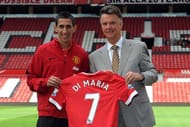
The Premier League’s most expensive player to date was a familiar name around the planet. For anyone who had watched Spain’s La Liga or the Portuguese Primeira Liga, Argentinian winger Angel Di Maria was one of the best throwbacks to older, far more quaint times in football.
Before the Eden Hazard-like widemen who hog the ball and dribble on the spot without really whipping in crosses. Before the Cristiano Ronaldo-like widemen who stay up front and head in corners as they run right in the middle of the park. Before the hybrid forward-side-midfielder, there was the classic No.7.
Back then, a little child who was selling coal for a living in Argentina used to spend his free time on the football pitch, dreaming of emulating his heroes to show off to his friends before he had to go back to the hard struggle that was reality. It was a little boy who his family called their angel; Angel Di Maria.
Starting out in 2005, he became a sensation at local club Rosario Central. Despite his thin, wiry frame, his breath-taking pace, and ridiculous dribbling ability were already exciting agents and scouts who had come to watch the little boy. Very soon, the young man’s wings spread as his career took flight. Where to?
Europe, where Portuguese club Benfica were gleefully awaiting one of their latest South American recruits. After all, he’d not come very cheap at roughly €7 million. Before long, he made it obvious how cheap that really was. With a left foot made of gold, the Argentinian winger reminded everyone what that word really meant.
A touchline-hugging cheetah, he sprinted past anyone before him. A bamboozling showman, he oozed class and trickery from every inch of his thin frame. The big clubs’ scouts couldn’t hold their breath lest he blew past them, leaving shirts trailing and knees crisscrossed in his wake.
Wickedly whipped in crosses curved wonderfully onto outstretched heads. Set-pieces swung in skillfully, reminding one of a younger David Beckham. Di Maria was just a youngster, but it was clear that he was destined for the big-time. In 2010, Jose Mourinho and Real Madrid could wait no longer and they launched a bid of €25 million (plus €11 million in incentives). Benfica saw the glitter in the young man’s eyes and it was accepted. He was officially a new Galactico.
His career started brilliantly. Wearing the white jersey, Di Maria became Jose Mourinho’s first-choice on the wings. With the tall, super-fast Cristiano Ronaldo up top, he could whip in crosses all day – they would be headed in. Karim Benzema enjoyed his new teammate's incredible eye and even his international teammate Gonzalo Higuain profited amazingly from Di Maria’s trademark outside-of-the-boot defence-splicing passes.
His art was getting finer by the day; he wasn’t just explosive anymore – he was like a footballing surgeon at work. When Carlo Ancelotti signed for Real Madrid, Gareth Bale was stolen from Tottenham for the world record transfer fee. Di Maria was expected to suffer, as Bale had something he didn’t – a great passing ability. That mattered not to flying winger, whose wings grew even bigger.
Readjusted by the genial Ancelotti to a midfield role, Di Maria grew even stronger, displaying some of his finest football ever. He became the man behind Ronaldo, the forward who set the pace, the guy who made the crosses and the player who controlled their expensively-assembled attack. While Bale and Ronaldo grabbed all the headlines with their goals, Di Maria won everybody’s hearts with his incredible football.
On the day of the biggest game of his club career, it was El Derbi Madrileno – with a continental twist. Atletico Madrid, the side that could halt them all in their tracks, was up against them in Europe. After a tense 110 minutes of football (salvaged by that unforgettable Sergio Ramos goal), the two sides were equal.
Atletico were pushing, as they sensed their moment coming. However, they lost the ball and were suddenly on the back foot. It was a snap moment – once in a lifetime, and Di Maria had to try. He snatched the ball away and immediately turned into the cheetah he’d grown up to be. Searing speed, tearing the pitch into shreds behind him – a single focus, the goal at the other end.
A red-and-white shirt; he bamboozled the Rojiblanco defender. At his mercy – eternal glory. He fired, and a brilliant save couldn’t stop Madrid from scoring as Gareth Bale broke the Atletico resistance. Bale & Ronaldo were the heroes, but he lifted the European Cup and the match-ball as the UEFA Champions League final man-of-the-match. Weeks later, he was moved on. Months later, Madrid regretted it & sacked their Decima-winning manager. A year later, it was United’s turn to move their manager on and regret their ludicrous transfer of the winger to PSG.
Angel Di Maria – the little boy who sold coal to survive – is the most complete winger on the planet and the Premier League’s most expensive player in history!
